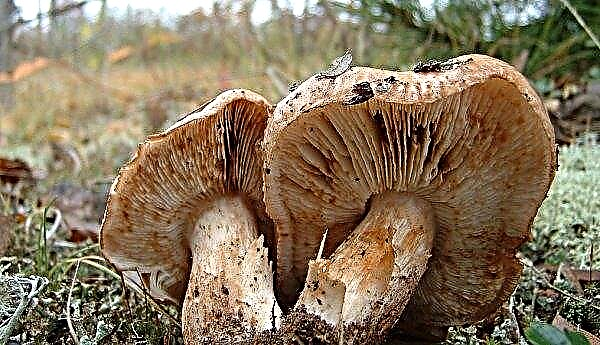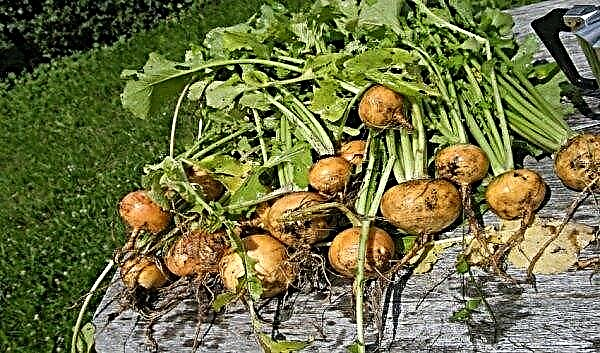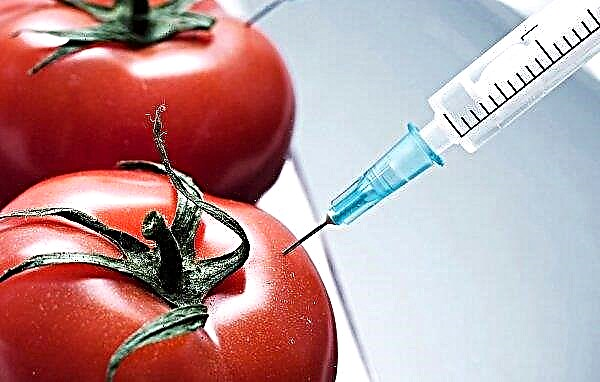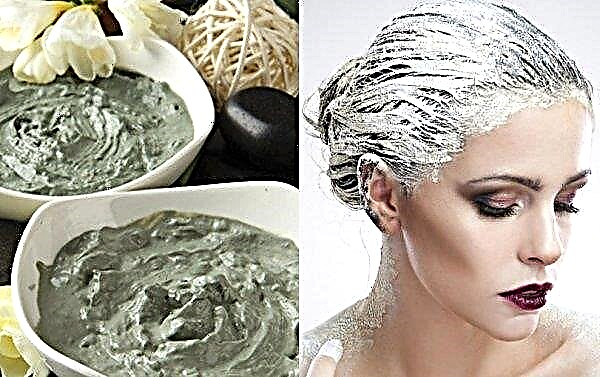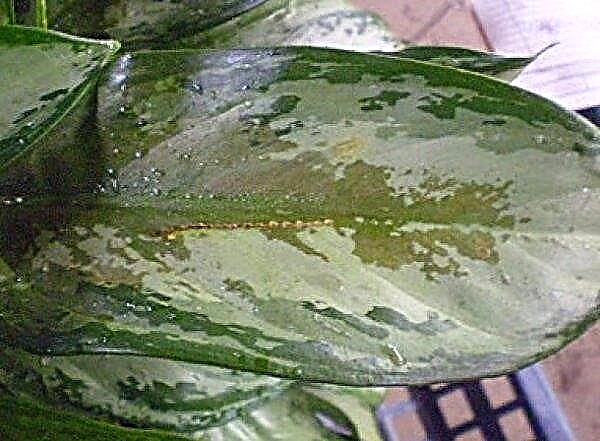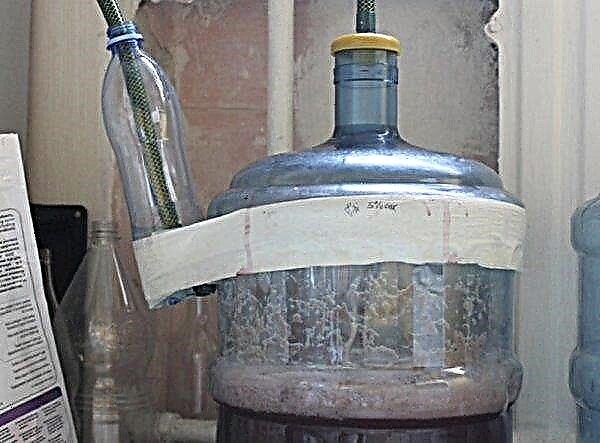Year-round consumption of fresh dill is quite possible. And for this it is not necessary to buy a healthy spice. Get it real, even on the home windowsill. What you need in order to independently grow lush dill branches in the apartment in the winter, and what difficulties often arise in this case, find out further from the article.
Is it possible to grow dill on a windowsill in winter
Due to unsuccessful attempts, many people do not accept home cultivation of greenery, believing that the resources spent on it are much more expensive than the purchased product. But in fact, the complexity of the agrotechnical process is due to errors made in the process of selecting seeds, sowing and caring for seedlings.
Did you know? The ancient Romans and Greeks gave their darlings bouquets of dill branches. This gesture was interpreted not as a hint of cooking a delicious dish, but as a sign of great love and devotion.
Dill is an undemanding plant and develops well in room conditions. To do this, he needs to provide:
To do this, he needs to provide:
- good lighting (windowsills of a southern orientation are desirable, otherwise you will have to use phytolamps);
- moderate soil moisture;
- optimal room temperature;
- timely top dressing.
What varieties of dill can be grown on the windowsill
It happens that when sowing house seeds, instead of thick, well-developed seedlings with a rich aroma, thin and lifeless blades appear in the pot. The reason for this is incorrectly selected varieties of dill.
Important! If you need additional highlighting of dill crops, place lamps at a distance of half a meter from the planting container and make sure that the plant is lit daily for at least 14–15 hours.
Experienced housewives for cultivation advise high-yielding varieties.
Among them are especially popular:
- Gribovsky - matures in 40–55 days, is unpretentious, resistant to common diseases and high palatability;
- Grenadier - has a rich aroma and juiciness of large leafy greens that appears 30 days after sowing;
- Further - characterized by the average size of the wax foliage, high taste and marketability, tolerates transportation well, technical maturity occurs on the window 40 days after sowing;
- Aurora - ultra-early undersized variety, the main characteristics of which are a sprawling rosette and fragrant slightly cut foliage that appears 25 days after sowing;
- Richelieu - differs in a bluish-green shade of branches and pronounced spicy taste, technical maturity occurs after 55 days;
- Kibray - It is advantageous for its high commercial and taste qualities, its luxurious broad-leaved greens appear after 55-60 days;
- Gourmet - the technical maturity of this late-ripening variety occurs after 65 days, the bushes are dense and well leafy.
 Considering that there is no special dill variety for window growing on greens, experts when choosing seeds recommend paying attention to the timing of the technical and biological ripening of the crop.
Considering that there is no special dill variety for window growing on greens, experts when choosing seeds recommend paying attention to the timing of the technical and biological ripening of the crop.The fact is that early specimens often form peduncles and have a sparse green mass, while late ripe ones, on the contrary, build up thick branching on the windowsill.
Optimal conditions and terms for landing
In order for the dill sown at home to give good shoots, it is necessary for him to create favorable conditions.
This is about:
- Temperature conditions within + 17 ... + 20 ° C. The container with greens cannot be kept on the balcony after the autumn frosts, but sometimes it is allowed to take out to fresh air. If the window glass is cold outside, the dill greens may freeze.
- Humidity at the level of 40-50%. At higher rates, the plant may be affected by powdery mildew, and with high dryness, seedlings will die.
- Harmonious ratio of light and heat, which prevents stretching of the seedlings. If the room temperature is above + 20 ° C, you need to increase the light. It is also recommended to lower the temperature in the first 10 days after the shoots appear at night, opening the window transom.
From the time of sowing dill grains depends on the care of seedlings. It is easier to cultivate homemade greens on the windowsill from the beginning of spring to the end of summer, because natural lighting is enough to build up lush biomass. To obtain it, fertile soil and stable moisture are sufficient. More attention needs sprouts sown in autumn and winter. Without additional illumination, they will stretch and fall. Consequently, not only electrical appliances will be needed, but also regular fertilizing with complex mineral fertilizers and organics.
More attention needs sprouts sown in autumn and winter. Without additional illumination, they will stretch and fall. Consequently, not only electrical appliances will be needed, but also regular fertilizing with complex mineral fertilizers and organics.
However, if you aim to grow spices for fresh consumption in winter, it is better to plant dill in October. And for year-round supply of a product to your family, it is advisable to carry out several crops in different containers from the beginning of summer to the end of spring.
Did you know? Initially, dill came into human life exclusively as an ornamental plant, the aroma of which was desired in every home.
How to plant dill
The success of growing homemade greens largely depends on the characteristics of planting containers, the quality and nutritional value of the substrate, seed preparation, as well as the technology of sowing.
Preparing containers for landing
Dill has a well-developed root system of the rod type and for its full development requires the presence of deep bulk containers. When choosing one, give preference to containers with a depth of 15–20 cm. Indeed, the height of the aerial parts of this garden crop is proportionally proportional to the size of the roots.
Therefore, the lower the box, the poorer the bushes in it. For sowing, you can use plastic garden containers or home-made wooden boxes. As an alternative, any improvised containers with the proper depth will do. Some housewives prefer to plant greens in plastic bottles with a volume of 6-10 l with a cut side.
For sowing, you can use plastic garden containers or home-made wooden boxes. As an alternative, any improvised containers with the proper depth will do. Some housewives prefer to plant greens in plastic bottles with a volume of 6-10 l with a cut side.
In any case, there should be drainage holes at the bottom of the tank (if necessary, they must be made by oneself). Otherwise, the plant will be affected by root rot, a favorable environment for which will be stagnant water.
To avoid this, you need to start sowing with the disinfection of the selected pot with a weak solution of potassium permanganate. After that, it is filled with a layer of expanded clay with a thickness of about 3 cm.
Did you know? The famous Russian writer Nikolai Nekrasov adored dill. This greens at his request should have been present in all first and second courses.
Soil preparation
For better germination of dill grains, a loose nutrient soil with neutral acidity is required.
You can use the purchased universal substrate or you can cook it yourself from the following components:
- garden land (1 hour);
- river sand (0.5 hours);
- high peat (2 hours);
- compost or humus (1 hour).
 Before sowing, the soil (including store soil) is disinfected.
Before sowing, the soil (including store soil) is disinfected.There are several ways to do this:
- Steaming the mixture in a double boiler or scalding with boiling water. Under the influence of high temperatures, pathogenic microbes will die, but after the procedure, the soil will need to be dried for some time. It is important at this stage to prevent favorable conditions for the development of a pathogenic environment.
- Roasting in the oven. The method, like the previous one, is based on the influence of a short-term increase in the temperature regime. Its danger lies in the fact that an excessively long stay of the earth in such conditions can burn out all the useful elements from it, therefore, it is necessary to disinfect the substrate with the oven quickly, after preheating it to + 200 ° С.
- Chemical disinfection (weak solution of potassium permanganate or "Fitosporin").
Seed treatment
Given the thickness of the peel on dill seeds, as well as the amount of essential oils contained inside, it is advisable to soak the planting material in warm water for 3 days before sowing. And in order to protect the grains from pathogenic bacteria, change the fluid several times daily.
Important! So that dill does not lose its freshness in the refrigerator, it is recommended to thoroughly rinse and dry it. After that, the greens should be put on a paper towel in a glass container and sealed with a lid.
To accelerate their germination, with the last change of water, you can add a few drops of any growth stimulator (Kornevin, Emistim, Ecosil).
Sowing technology
Subject to all agrotechnical rules for sowing, dill greens, depending on the variety, will appear in a month and a half.
To meet the requirements of the culture and provide the necessary conditions for its growth, proceed step by step according to the instructions below:
- Fill the washed and disinfected containers with the prepared substrate and level it. Make sure that about 3-4 cm of space is left on top. Otherwise, you will not be able to water the plant.
- Moisten the substrate with plenty of settled water at room temperature. Wait until the earth has completely absorbed moisture.
- Sow the seeds. This can be done using rows with a depth of about 1-1.5 cm, or simply by distributing them on the soil surface. After that, the "bed" is sprinkled with a fresh substrate and palms it lightly tamped.
- To accelerate seedlings, the container is closed with glass or plastic film and removed in a dark and warm place.
How to care for dill
Spices growing on the windowsill require enough heat, nutrients and moisture. Otherwise, the seedlings can stop growing, lose their juiciness and richness of greenery.
Important! After emergence, it is recommended to lower the temperature in the room at night to strengthen and juiciness of the sprouts.
The key to luxurious dill bunches are:
- Timely moderate watering. If you want to get a crop grown on a windowsill all year round, consider the seasonal moisture needs of the plant. In the spring-summer season, he will need daily abundant moisturizing procedures, and in the winter they will be minimized, because with excess moisture, the risks of bacterial and fungal infections increase. It is important to monitor the condition of the soil in the pot, preventing waterlogging and dryness. Use water only warmed up and settled. Rain and melt are also acceptable, but its temperature should not be lower than room temperature.
- Regular top dressing. They are required subject to the use of depleted soil. If planting is made in a fertile substrate, then additional fertilizers can be omitted throughout the season. Otherwise, every 2 weeks you will need to nourish the roots of dill with organic and mineral substances. The best among the purchased assortment of gardeners is called the drug "Growth", "Agrolife", the effect of which is equivalent to biohumus. Also, nitrogen-containing substances will not be superfluous. But do not forget that any greens do not like the excess of minerals, so excessive feeding will only harm.
- Daily spraying of biomass. Be sure to spray several times a day with dill foliage. This will contribute to her juiciness and good growth.
- Stable temperature. It is important that in the room where the boxes with greens are placed, the temperature should correspond to the range + 15 ... + 18 ° С. It is unacceptable for the thermometer to drop below + 8 ° C or rise above + 25 ° C.
- Monthly planting of crops. This is due to the fact that cut dill branches do not grow back. Some housewives advise in the fall before frost to transplant an old dill bush from the garden into a pot and sow new seeds in it. Otherwise, you will have to sow new "beds" every half month.

How much dill grows at home
When a fresh aromatic spice appears on your window, it depends on the selected variety and the observance of the agricultural technology of its cultivation.
If you do everything right, then:
- early ripe bushes can be cut in 25–35 days after planting grains;
- mid-season - after 35–45 days;
- late ripening - after 45 days or more.
Subject to sufficient lighting, heat and moisture, the first sprouts will appear 2 weeks after rooting.
Possible growing difficulties
Dill is an unpretentious garden crop, and there are no special difficulties with its home cultivation. Lush spice bushes can be grown even by novice gardeners if they provide the plant with a well-lit window sill, and the recommended heat and moisture regimen.
Inhibition of growth and elongation of sprouts indicates improper cultivation and inappropriate conditions.
Lack of growth
The reason why dill does not grow on the windowsill should be sought in the level of illumination, as well as in the fertility of the soil. Carefully inspect the seedlings for symptoms of diseases and signs of pest activity. In their absence, pour the culture with nitrogen-containing substances. Loosen the soil once a week after watering in the root aeration box. Such manipulations will enhance the development of dill. And also make sure that the air temperature in the apartment is + 18 ° С, and the daylight hours for the plant should be at least 15 hours.
In their absence, pour the culture with nitrogen-containing substances. Loosen the soil once a week after watering in the root aeration box. Such manipulations will enhance the development of dill. And also make sure that the air temperature in the apartment is + 18 ° С, and the daylight hours for the plant should be at least 15 hours.
Important! With high germination of dill seeds, thick sowing should be thinned so that the distance between plants is at least 2-3 cm.
Sprouts of dill
This happens when there is not enough light in the room. In winter, be sure to illuminate the crops with lamps. It is important to place them above the crops so that the light spreads evenly over the entire tank.
Useful growing tips
In order for home dill to develop at an accelerated pace into lush sockets, experienced housewives advise:
- At elevated temperature of cultivation, respectively, increase the daylight hours. Otherwise, the sprouts are very elongated or do not stop growing at all. This recommendation is especially relevant in the winter when heating systems are turned on.
- Regularly turn containers with greens in different directions to the window, because the shoots tilt toward the light source over time.
- After emergence, do not immediately remove the shelter from the container, but begin to gradually adapt to the environment. To do this, on the first day, the container is opened for half an hour, with each subsequent day increasing the interval by 2 times. Already after 10-12 days from the landing capacity, you can completely remove the shelter.
 Dill from the windowsill is a real find in the winter and a way to save on purchased products. To grow homemade greens do not need special equipment and knowledge. Unpretentious spices need basic care and a little attention.
Dill from the windowsill is a real find in the winter and a way to save on purchased products. To grow homemade greens do not need special equipment and knowledge. Unpretentious spices need basic care and a little attention.

